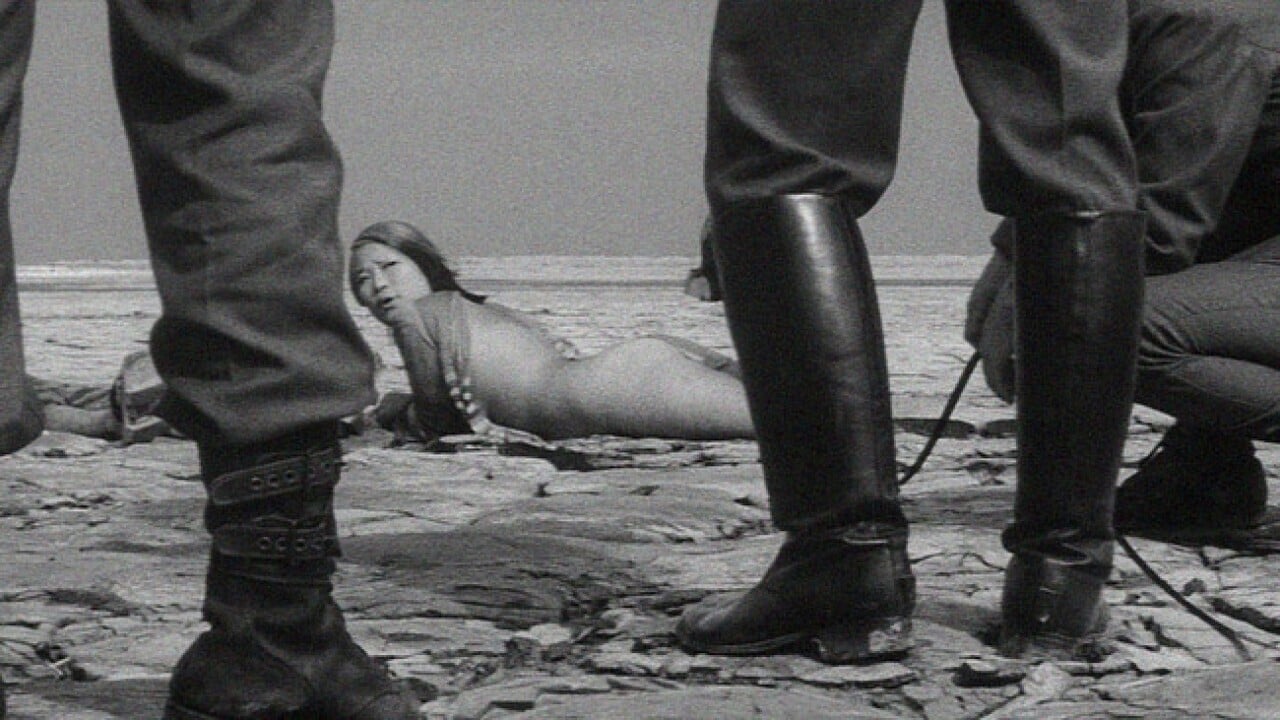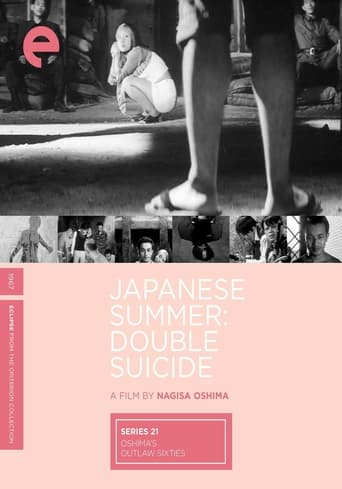



Absolutely Brilliant!
Absolutely brilliant
Simple and well acted, it has tension enough to knot the stomach.
View MoreThis movie feels like it was made purely to piss off people who want good shows
View MoreViewed on DVD. Restoration = five (5) stars. Director Nagisa Oshima delivers a trashy 90 minute strip tease. The star and sole attraction here is sex-bomb actress Keiko Sakurai who although a bit chunky is exceptionally well endowed. Her bouncy, semi nude, and simulated sex scenes are scatted throughout this ludicrous movie and meant to keep adolescent members of the audience in their seats. To see Sakurai in action, viewers in the theater were forced to sit through rambling, meaningless, and trite dialog spouted by what has to be some of the most unappealing actors filmed in a Japanese movie--their ugliness is amplified by exhibiting their out-of-shape bodies in mostly half naked fashion. (Fortunately, disc viewers have fast-forward buttons on their remotes to skip this stuff.) To say that scenes lack continuity is to put it mildly. Early shots provide some fine existential views--especially those showing empty freeways--together with provocative symbolism. But this gets quickly buried (and forgotten) in the abject silliness that follows. Cinematography (wide screen, black and white) is quite good with one of the longest tracking shots (if not the longest) in Japanese films to that date. The Director often uses home-movie style, back-and-forth panning between speaking actors instead of cuts (which allows him to show off and, at the same time, induce headaches in the viewer). Music is (mercifully) close to nonexistent. Subtitles are often too long and interfere with viewing Sakurai in action. (Since they poorly translate the spoken nonsense, the viewer might want to turn them off together with the audio track so as to better see (and concentrate on) the actress' performance.) Best to locate the remote fast-forward button before playing. WILLIAM FLANIGAN, PhD.
View MoreA film sometimes will stay with you for an inexplicable reason. This time, it's not so hard to figure out - Nagisa Oshima decided to make a film that is not too long, maybe 90 minutes or so (I forget the exact running time), set most of it in one location, and make it about how human nature is just really, really strange sometimes. Especially in Japan. Now, contrary to what the title says, it's not really a film about suicide, at least not fully. One of the main characters IS fascinated by wanting to off himself, and keeps on trying to find a way to do it. And he's accompanied by a young 18 year old woman who is quite aroused and wants to get her rocks off with another man. Then there is the other guy who is just really hyped up on guns. But what is the movie about? Well, I'm still not sure if it has an exact narrative that can be seen as A-B-and-C straight through. It's more in line with something like the Exterminating Angel, as close as I can figure, as it's about how the suicide guy and horny girl are walking along one night (he her boyfriend, sorta), and they get caught up in a hide-out where a bunch of men are paranoid about a war starting, or some kind of attack. And their fears are amped up by reports on the news of a white-American gunman taking out people at random. There is a lock-down, but the people in this big gray hangar could leave whenever they want. But things keep on happening to keep them there...It's maybe a film that most pointedly and wonderfully looks at male frustration and nihilism, with this one girl who keeps trying to have something with a man (and failing, not for lack of being attractive but just because the men are pre-occupied with their "guns" so to speak), and paranoia in general. I loved the atmosphere of everything in this one place, as the people are there and they don't leave, at least until the last fifteen minutes or so. When they do leave, Oshima makes some real suspense and action, but not how one would expect. It's technically a thriller, but everything is underlying, and the suspense isn't for the when but how things will happen. I loved it, but it's definitely an acquired taste.
View MoreI know a few of this man's films. They are among the richest experiences I know, but I was surprised at how deeply this one worked on me.The surprise comes in part from knowing how specific his target audience was. I am the right generation but the wrong decade and culture. I recently encountered the effect with "Naisu no mori" which took some significant shifting on my part to put me in the right place.Oshima is politically radical, violently iconoclastic and deeply critical of what he sees as a broken Japanese culture. In this film he targets sensibilities that would be hard for even Japanese viewers to understand today. I didn't even try, and simply relegated all the broken souls I saw to a generalized brokenness. Perhaps that makes the film better, because it allows us to experience the technique of the thing more directly.The story doesn't matter except that it throws an eighteen year old girl with a "screw loose" in with a suicidal AWOL soldier and a group of ragtag gangsters. Some of the action takes place in an abandoned futuristic city, but the core of the film is in a bunker of some sort. It is a terrific set and one wonders how in the world many of the shots were made. Some of them pan the space, showing walls that could not have been there at the start of the shot.It is a complex space, concrete, with sometimes deep, sometimes close walls that seem to change. The floors and ceilings have different heights. There are stone altar slabs with spring water coming from roughly hewn holes. Sometimes the walls and floors have handcarved human-shaped niches. The lighting always seems natural but the sources would be physically impossible. The space reminded me of Tarkovsky.Oshima says he hates Ozu and Kurosawa, but the cameras of both clearly is used and extended here. The poses are formal, the movements of the eye architectural. This film was unknown to me until today, and it replaces Welles' Othello as my go to example of an architectural film. The characters are less people than they are active components of the space. Every action, every perception — ours and theirs — is spatially situated. I loved it. Mind you, this is in spite of missing the social commentary; some would think it was if I were watching a mimed Shakespearean play. But I think this film is in the eye, the space.It is so extraordinary that I am giving it one of my coveted 4 ratings.Ted's Evaluation -- 4 of 3: Every cineliterate person should experience this.
View MoreThis is possibly the best film Nagisa Oshima ever made; and one of the more accessible.The film begins somewhere in the near future, in Japan. The streets and roads are empty of civilians, only the occasional police car or military squad march down the road.Our protagonist, Nejiko, a attractive and frustrated adolescent is attempting to seduce policemen and soldiers; but none are interested, their busy fulfilling their duty. Nejiko eventually bumps into deserter soldier Otoko (played by Oshima regular Kai Sato) - he is also wandering around alone searching for something; unfortunately for Nejiko he isn't interested in sex, he wants to find someone to kill him. The pair end up getting taken to a secret compound by 'gangsters' who turn out to be members of a secret army plotting to overthrow the government.The bulk of the film takes place in this military compound inside one of the sheds where Otoko, Nejiko and a group of mercenaries are waiting on orders (and weapons) from the leaders. Unfortunately for the would-be revolutionaries a Westerner is driving throughout Japan in a car on a rampage sniping people; resulting in all the police and military being deployed trying to stop him; and he gets ever closer to the secret army's military base.But whilst all the mercenary men discuss their past, their justification of violence, their favoured weapons, poor Nejiko just wants one of them to make love to her!The film later on leaves the barracks and goes on a search with several members of the group. The cinematography resembles Resnais' in Hiroshima Mon Amour, which is one of my favourite films, but I think this film beats it!Oshima fills his film with a group of completely differing mysterious characters, forces them in close proximity to each other and observes them interacting often with explosive results. None really have importance over the other, and all are flawed. For me, this film is about the search for Japanese pride after World War 2; and the absurd importance placed upon it above all others things. Oshima critiques each different group's reaction - the students, the police and army, the elderly, the war criminals, the businessmen. Only the women are left uncriticised.. The one woman in the film, the only one brave enough to leave her home and get what she wants, just gets in the way of the men looking for their pride- ignoring the fact that a new Japan can only be brought about by the two coming together and starting anew.
View More